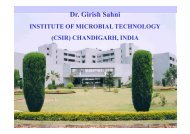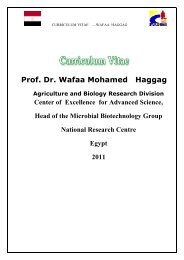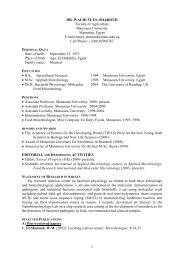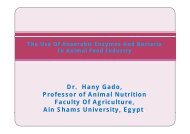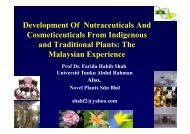Presentation
Presentation
Presentation
You also want an ePaper? Increase the reach of your titles
YUMPU automatically turns print PDFs into web optimized ePapers that Google loves.
ENGINEERING OF DAIRY PROTEINS AND THE MODULATION OF<br />
THEIR STRUCTURES -<br />
MICELLISATION AND IMMUNO REACTIVITIES OF<br />
DIMERIC DIMERIC BETA BETA CASEINS CASEINS.<br />
Thomas Haertlé<br />
Institut National de la Recherche Agronomique, Nantes, France<br />
The France-Egypt Year Of Science And Technology, 2010
Importance of milk<br />
Essential food of newborn (nutrition, immune protection,<br />
enzymes).<br />
Cow, goat and sheep in Western countries.<br />
Mare, water buffalo, camel, yak…in y Eastern countries.<br />
Consumed without or after transformation (cheeses, fermented<br />
milks).<br />
Of great importance for food industries of each human society.<br />
The France-Egypt Year Of Science And Technology, 2010
Average composition<br />
of f cow milk ilk<br />
Synthetisised by secretory epithelial cells (synthesis of<br />
components or their capture from blood)<br />
12 12-13 13 % of fd dry matter tt (120-130 (120 130 g/L) /L)<br />
PProteins i (32-35 g/L) LLactose (47-52 g/L) FFats<br />
(33-45 g/L)<br />
Caseins (26-28 ( g/L) g )<br />
Precipitation at pH 4,6<br />
The France-Egypt Year Of Science And Technology, 2010<br />
Salt min.<br />
(7 g/L)<br />
BLG<br />
(2 (2-44 g/L) /L)<br />
Wh Whey<br />
ALA<br />
(1-1,5 g/L) LF<br />
Ig BSA
Bovine caseins<br />
Casein αS1 αS2 β κ<br />
AA<br />
199<br />
207<br />
209<br />
169<br />
MM (kDa) 23,6 25,25<br />
24<br />
19<br />
Variants 5<br />
3<br />
6<br />
6<br />
Cys<br />
0<br />
2<br />
0<br />
2<br />
S-S Bridges 0<br />
0<br />
0<br />
0<br />
Ser-P Ser P<br />
8<br />
11<br />
5<br />
2<br />
Glycosylation No<br />
No<br />
No<br />
Yes<br />
Major ep. 6<br />
4<br />
6<br />
8<br />
Minor ep. 3 66<br />
3 0<br />
UUnknown k th three-dimensional di i l structures t t<br />
Unknown functions (nutritional, only ?)<br />
Quite often allergenic.<br />
The France-Egypt Year Of Science And Technology, 2010
Caséine κ<br />
169 aa<br />
19037 Da<br />
1<br />
Chymosine<br />
Glycosylation<br />
Cys y Cys y<br />
P of caseins<br />
11 Para-Kappa 88 105/106 CMP 149<br />
Hydrophobe<br />
Hydrophile/chargé -<br />
Caséine β<br />
209 aa<br />
23983 Da<br />
Amphiphile<br />
Plasmine Plasmine<br />
P PPP<br />
P<br />
1 15 17-19 35<br />
105/106<br />
209<br />
28/29 107/108<br />
Hydrophile/chargé -<br />
Caséine αs2 207 aa<br />
25226 Da<br />
Amphiphile<br />
PPP P P CysCys PPP<br />
P<br />
P P P<br />
Tè Très peu chargé h é<br />
Hydrophobe<br />
1 8-10 16 31 56 56-58 5 61<br />
129 131 143<br />
207<br />
36 40<br />
Hydrophile/chargé -<br />
Caséine αs1 199 aa<br />
23615 Da<br />
Hydrophobe<br />
Dipôle<br />
PP PPP P P P<br />
1 46 48 64-68<br />
75 115<br />
199<br />
Hydrophobe Hydrophile/chargé - Hydrophobe Hydrophobe<br />
169<br />
The France-Egypt Year Of Science And Technology, 2010<br />
Physico-chemical properties<br />
of caseins<br />
Casein micellisation according to Holt<br />
(1998)
20 - 300 nm<br />
(Schmidt, Schmidt, 1982 ; Walstra, 1984)<br />
1984<br />
Casein micelle<br />
The France-Egypt Year Of Science And Technology, 2010<br />
glucids<br />
submicelle<br />
α αs11 αs β 2<br />
κ<br />
CCP Colloidal Calcium<br />
Phosphate
P<br />
P P P<br />
β casein<br />
MKVLILACLV ALALARELEE LNVPGEIVES LSSSEESITR INKKIEKFQS<br />
EEQQQTEDEL QDKIHPFAQT QSLVYPFPGP IPNSLPQNIP PLTQTPVVVP<br />
PFLQPEVMGV Q SKVKEAMAPK HKEMPFPKYP VEPFTESQSL Q TLTDVENLHL<br />
PLPLLQSWMH QPHQPLPPTV MFPPQSVLSL SQSKVLPVPQ KAVPYPQRDM<br />
PIQAFLLYQE PVLGPVRGPF PIIV<br />
Phosphorylation calcium fixation (binding of other caseins by<br />
phosphocalcic bridges)<br />
Hydrophilic NN-terminus terminus (several negative charges)<br />
Long hydrophobe C-terminal sequence<br />
AMPHIPHILIC PROTEIN<br />
structures polyproline II<br />
Numerous Numerous prolines (35) scarce classic secondary structures (β sheets, sheets α helices …)<br />
)<br />
The France-Egypt Year Of Science And Technology, 2010<br />
P
Self-association of β casein<br />
Micellar aggregates<br />
Temperature and<br />
concentration ddependent d<br />
The France-Egypt Year Of Science And Technology, 2010<br />
Andrews et al. , 1979<br />
Payens et al., 1963<br />
Farrell et al., 2001<br />
Thurn et al. , 1987<br />
Kajiwara et al. , 1988<br />
Sood et al. , 1990<br />
Sood et al. , 1997<br />
Leclerc et al. , 1998<br />
Leclerc et al. , 1997
F I<br />
Trp 143<br />
monomer<br />
λ<br />
↑ °CC<br />
Intrinsic Fluorescence of<br />
tryptophan tryptophan (1) (1)<br />
F I<br />
micelle<br />
λ max Trp = 341 nm λ max Trp = 336 nm<br />
The France-Egypt Year Of Science And Technology, 2010<br />
λ
Enginering of β casein<br />
Recombinant β casein, wild type, expressed in E. coli : WT<br />
Recombinant β casein, mutated, expressed in E. coli: MU<br />
MRELEEL RELEELNVPG EIVESLSSSE ESITRINKKI EKFQSEEQQQ<br />
TEDELQDKIH PFAQTQSLVY PFPGPIPNSL PQNIPPLTQT PVVVPPFLQP<br />
EVMGVSKVKE AMAPKHKEMP FPKYPVEPFT ESQSLTLTDV ENLHLPLPLL<br />
QSWMHQPHQP LPPTVMFPPQ SVLSLSQSKV LPVPQKAVPY PQRDMPIQAF<br />
LLYQEPVLGP VRGPFPIIV<br />
Sequence containing three glutamates well conserved in Ruminants<br />
Addition of three negative charges: change of hydrophilic/hydrophobic ratio<br />
The France-Egypt Year Of Science And Technology, 2010
Same conditions as<br />
for DLS.<br />
λmmax<br />
Trp<br />
1 mg/mL<br />
00,4 4 mg/mL<br />
λmaxTrp<br />
0,2mg/mL<br />
λmaxTrp max Trp<br />
λm<br />
342<br />
340<br />
338<br />
336<br />
334<br />
332<br />
342<br />
340<br />
338<br />
336<br />
334<br />
332<br />
Native<br />
Intrinsic Fluorescence of<br />
Tryptophan Tryptophan (1) (1)<br />
(2)<br />
10 20 30 40 50<br />
Temperature, °C<br />
WT<br />
10 20 30 40 50<br />
T emperature, t °C<br />
Temperature, °C<br />
λmmaxTrp<br />
max Trp<br />
λm<br />
The France-Egypt Year Of Science And Technology, 2010<br />
342<br />
340<br />
338<br />
336<br />
334<br />
332<br />
MU<br />
10 20 30 40 50<br />
Temperature, °C
Beta casein native<br />
+ 3 HNeRELEELNVPGEIVESLSSSEESITRINKKIEKFQSEEQQQTEDELQDKIHPFAQTQSLVYPFPGPIPNS<br />
3<br />
LPQNIPPLTQTPVVVPPFLQPEVMGVSKVKEAMAPKHKEMPFPKYPVEPFTESQSLTLTDVENLHLPLPLLQ<br />
SWMHQPHQPLPPTVMFPPQSVLSLSQSKVLPVPQKAVPYPQRDMPIQAFLLYQEPVLGPVRGPFPIIV<br />
COO -<br />
Beta casein simple mutant C4<br />
+ 3 HNeMGRELECLNVPGEIVESLSSSEESITRINKKIEKFQSEEQQQTEDELQDKIHPFAQTQSLVYPFPGPIPNSLPQNIPPLTQTP<br />
VVVPPFLQPEVMGVSKVKEAMAPKHKEMPFPKYPVEPFTESQSLTLTDVENLHLPLPLLQSWMHQPHQPLPPTVMFPPQSVLSL<br />
SQSKVLPVPQKAVPYPQRDMPIQAFLLYQEPVLGPVRGPFPIIV COO -<br />
Q Q Q Q Q<br />
Beta casein simple mutant C208<br />
+ 3 HNeMGRELEKLNVPGEIVESLSSSEESITRINKKIEKFQSEEQQQTEDELQDKIHPFAQTQSLVYPFPGPIPNSLPQNIPPLTQTPV<br />
VVPPFLQPEVMGVSKVKEAMAPKHKEMPFPKYPVEPFTESQSLTLTDVENLHLPLPLLQSWMHQPHQPLPPTVMFPPQSVLSLS<br />
QSKVLPVPQKAVPYPQRDMPIQAFLLYQEPVLGPVRGPFPICV COO -<br />
Beta casein double mutant C4 - 208<br />
+ 3 HNeMGRELECLNVPGEIVESLSSSEESITRINKKIEKFQSEEQQQTEDELQDKIHPFAQTQSLVYPFPGPIPNSLPQNIPPLTQTP<br />
VVVPPFLQPEVMGVSKVKEAMAPKHKEMPFPKYPVEPFTESQSLTLTDVENLHLPLPLLQSWMHQPHQPLPPTVMFPPQSVLSL<br />
SQSKVLPVPQKAVPYPQRDMPIQAFLLYQEPVLGPVRGPFPICV COO -<br />
The France-Egypt Year Of Science And Technology, 2010
SDS-PAGE of bovine β casein and mutants.<br />
Experimental condition: SDS‐PAGE (12.5 % gel), under reducing conditions.<br />
Coomasie blue staining.<br />
The France-Egypt Year Of Science And Technology, 2010
SDS-PAGE<br />
BCN C4-<br />
208<br />
Oxydation<br />
24 h at 25°C pH 6,5<br />
WT<br />
BCN C4 BCN C4-<br />
208<br />
BCN C4 WT<br />
kDa 0 1 10 24 M 0 1 10 24 0 1 10 24 M 0 1 10 24<br />
97,4<br />
97,4<br />
Trimer<br />
66,2<br />
Dimer<br />
Monomer<br />
«Intra» a<br />
66,2<br />
45<br />
31<br />
2 cys 1 cys<br />
The France-Egypt Year Of Science And Technology, 2010<br />
2-mercaptoethanol<br />
kDa<br />
45<br />
31<br />
21,5
SDS-PAGE of the dimerizing β casein mutants<br />
Condition: Tris buffer 50 mM mM, pH 88.2 2 including 80 mM NaCl and H2O2 H2O2, 37 °CC,<br />
stirred, sterile.<br />
The France-Egypt Year Of Science And Technology, 2010
• RReasons ffor quicker i k dimerization di i ti kinetics ki ti of f C208 ßß-CNs CN<br />
Greater mobility y of C-terminal segment g<br />
Easier access of SH function<br />
Hydrophobic interactions<br />
• The dimerization sites in C6- and C-208 ß-CNs<br />
• RELECSH(4)NVPGEIVESLSSSEESITRINKKIEKFQSEEQQQTEDEL<br />
QDKIHPFAQTQSLVYPFPGPIPNSLPQNIPPLTQTPVVVPPFLQPEVMGV<br />
• SKVKEAMAPKHKEMPFPKYPVEPFTESQSLTLTDVENLHLPLPLLQSWMH<br />
• QPHQPLPPTVMFPPQSVLSLSQSKVLPVPQKAVPYPQRDM PIQAFLLYQ<br />
• EPVLGPVRGPF PIIVCSH (208)<br />
The France-Egypt Year Of Science And Technology, 2010
Hydrophilic Hydrophilic-Hydrophilic Hydrophilic patterns of different β CNs<br />
Native β CN has distinct arrangement of hydrophilic (ψ) -hydrophobic(φ)<br />
fragments (ψ- φ).<br />
The dimeric β CNs are in some sense symmetrical<br />
C208 β CND (ψ - φ ~ φ - ψ)<br />
C4 β CND (φ - ψ ~ ψ - φ)<br />
The France-Egypt Year Of Science And Technology, 2010<br />
"P "Palindromic" lid i"
Casein β<br />
-C-C-<br />
-C-C- C C<br />
23983 Da<br />
Plasmin Plasmin<br />
P PPP<br />
P<br />
1 15 17 17-19 19 35<br />
105/106<br />
209<br />
28/29 107/108<br />
Hydrophilic/charged -<br />
Amphiphilic<br />
Little charged<br />
Hydrophobe<br />
The France-Egypt Year Of Science And Technology, 2010
Chhaperone-like<br />
activity ac (%)<br />
Chaperone-like activities of native and mutant monomeric<br />
ββ-CN. CN TTarget t protein t i - iinsulin li<br />
120<br />
100<br />
80<br />
60<br />
40<br />
20<br />
0<br />
0 0,025 0,05 0,075 0,1 0,125<br />
(ß-CN /Insulin) molar ratio<br />
Native β-CN (■), Wild type β-CN (□), C4 β-CN (▲) and C208 β-CN (∆)<br />
The France-Egypt Year Of Science And Technology, 2010<br />
Chemically-induced<br />
aggregation of insulin<br />
performed f di in the th présence é of f<br />
20 mM DTT at 40 °C.<br />
Mutant β-CNs exhibit<br />
considerably smaller<br />
chaperone chaperone-activities activities than that<br />
of native β-CN.
Importance of phosphoryl residues for chaperone<br />
acivities of ßß-CNs. CNs<br />
The hydrophilic segment of chaperones plays an essential role<br />
increasing solubilities of target proteins.<br />
The expressed in E. coli recombinant ß-CNs are not phosphorylated<br />
what decreases their amphiphilicity<br />
amphiphilicity.<br />
Amino acid Sequence of native ß-CN and the sites for phosphorylation<br />
Smaller polarity of hydrophilic domain is the reason for poorer<br />
chaperone p<br />
activities of the mutant ß-CNs.<br />
The France-Egypt Year Of Science And Technology, 2010
Consequence of Cys incorporation on chaperone-like<br />
chaperone like<br />
activities of ß-CN.<br />
Absence of cysteinyl residues, is one of the common features among<br />
different chaperone families.<br />
The C4 ß-CN and C208 ß-CN have cysteinyl residue in position 4 and 208,<br />
respectively.<br />
The ß-CNs containing cysteine showed almost similar chaperone-like<br />
activities ti iti as WT ßß-CN. CN<br />
Thus incorporation of cysteine has no significant consequence in<br />
chaperone chaperone-like like acti activity it of monomeric ßß-CN. CN<br />
The France-Egypt Year Of Science And Technology, 2010
Chape erone-like activity y (%)<br />
120<br />
100<br />
80<br />
60<br />
40<br />
20<br />
0<br />
Chaperone-like activities of the dimeric β-CN.<br />
TTarget t protein-ADH. t i ADH<br />
0 0,25 0,5 0,75 1 1,25 1,5 1,75<br />
(β−CN/ADH) molar ratio<br />
C208 ββ-CND CND (▲) (▲): HHydrophobic d h bi core, Pl Polar ends. d<br />
C4 β-CND (∆): Polar core, Hydrophobic ends.<br />
The France-Egypt Year Of Science And Technology, 2010<br />
Due to combination of flexibility and<br />
amphiphilicity, ß-CN acts as a surfactant<br />
molecule in solution.<br />
The dimeric β-CNs resembles<br />
somehow bis (gemini) - surfactants.<br />
C208 β-CND (ψ ‐ φ ~ φ ‐ ψ) has<br />
greater chaperone activity than C6 β-<br />
CND (ψ ‐ φ ~ φ ‐ ψ).<br />
C208 β-CND also shows greater<br />
chaperone activity than mutant β-CNs β CNs in<br />
monomeric state.
−<br />
Average IgE<br />
(ng/ml)<br />
35<br />
30<br />
25<br />
20<br />
15<br />
The IgE-binding (immuno reactivity) of different molecular<br />
forms of ββ-CN. CN<br />
Sera from patients with milk<br />
allergies were used to<br />
determine immuno reactivities<br />
of different molecular forms of<br />
β-CN.<br />
Averaged results of 16 out of<br />
10 37 tested sera showing<br />
significantly greater IgE-<br />
5<br />
responses to different forms<br />
of ββ-CN CN<br />
0<br />
Native B-CN WT B-CN C4 B-CNM C208 B-CNM C4 B-CND C208 B-CND<br />
The France-Egypt Year Of Science And Technology, 2010
Summary<br />
ß-CN and its mutants undergo temperature-induced concentrationdependent<br />
micellisation.<br />
Polar phosphate residues and the NN-terminal terminal hydrophilic domain are<br />
important functional elements enhancing the chaperone-like activities of<br />
native β-CN.<br />
Dimerization of C208 β-CN with two distal hydrophilic domains improved<br />
considerably its chaperone-like activity in comparison with its monomeric<br />
form and with C4 β-CND.<br />
NN-terminal t i l hydrophilic h d hili domain d i plays l significant i ifi t role l as important i t t<br />
functional elements enhancing the chaperone-like activity of native β-CN<br />
Exposure of hydrophobic domains increases immuno reactivity in 208 ββ-CN CN<br />
dimer<br />
The France-Egypt Year Of Science And Technology, 2010
Our INRA team<br />
Isabelle Bronnec Aynur Akhmadova – PhD student<br />
JJean-Marc M Ch Chobert b t Sh Shady d El GGaish i h – PhD student t d t<br />
Yvan Choiset Tatyana Konnova – PhD student<br />
Michèle Dalgalarrondo Asghar Taheri Kafrani – PhD student<br />
Hanitra Rabesona Iuliya Schutskaya – PhD student<br />
Thomas Haertlé Reza Yousefi – post doctoral<br />
Collaborations<br />
Prof Dr V.I. Muronetz, Faculty of Bioengineering, Lomonosov University,<br />
Moscow, Russia<br />
Prof Dr Yu. D. Zuev, Institute of Biochemistry and Biophysics, RAS,<br />
Kazan, Russia.<br />
Prof Dr A. A. Moosavi-Movahedi, Institute of Biochemistry and Biophysics,<br />
Tehran University, IR Iran.<br />
The France-Egypt Year Of Science And Technology, 2010



